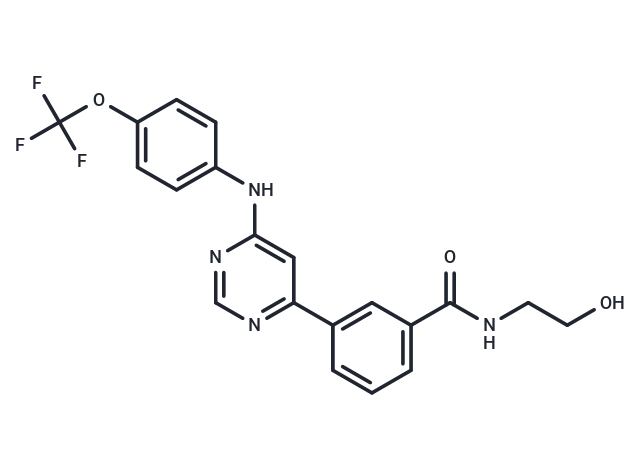Shopping Cart
- Remove All
 Your shopping cart is currently empty
Your shopping cart is currently empty

GNF-5 is a specific non-ATP competitive inhibitor of Bcr-Abl (IC50: 0.22±0.1 uM, Wild-type Abl). It is an analog of GNF-2 with improved pharmacokinetic properties.

| Pack Size | Price | Availability | Quantity |
|---|---|---|---|
| 10 mg | $30 | In Stock | |
| 25 mg | $47 | In Stock | |
| 50 mg | $81 | In Stock | |
| 100 mg | $119 | In Stock | |
| 200 mg | $215 | In Stock | |
| 1 mL x 10 mM (in DMSO) | $30 | In Stock |
| Description | GNF-5 is a specific non-ATP competitive inhibitor of Bcr-Abl (IC50: 0.22±0.1 uM, Wild-type Abl). It is an analog of GNF-2 with improved pharmacokinetic properties. |
| Targets&IC50 | BCR-ABL:0.22±0.1 μM |
| In vitro | Concurrent administration of GNF-5 (75 mg/kg) with nilotinib (50 mg/kg) has been shown to increase the overall survival rate in a T315I Bcr-Abl BMT model. Additionally, GNF-5 (100 mg/kg) demonstrated therapeutic efficacy against both wild-type and T315I Bcr-Abl-dependent proliferation in xenograft and bone marrow transplantation models. |
| In vivo | GNF-5 exhibits strong antiproliferative activities, inhibiting the proliferation of cells expressing wild-type Bcr-Abl (EC50: 430 nM) and its E255K mutant variant (EC50: 580 nM). When used in combination with nilotinib or imatinib, GNF-5 suppresses the emergence of resistant mutations in vitro and demonstrates enhanced inhibitory effects against the Bcr-Abl T315I mutant in both cell-based and biochemical assays. |
| Kinase Assay | Kinetic characterization of Abl inhibition: The ATP/NADH-coupled assay system in a 96-well format is used to determine the initial velocity of Abl tyrosine kinase catalyzed peptide phosphorylation. The reaction mixture contained 20 mM Tris-HCl, (pH 8.0), 50 mM NaCl, 10 mM MgCl2, 2 mM PEP [2-(Phosphonooxy)- 2-propenoic acid) and 20 μg Abl peptide substrate (EAIYAAPFAKKK), fixed or varied (to determine inhibitor kinetic parameters) concentration of inhibitor applied, 1/50 of the final reaction mixture volume of PK/LDH enzyme (pyruvate kinase/lactic dehydrogenase enzymes from rabbit muscle), 160 μM NADH, 0.16 μM Abl, and ATP added last to start the reaction. Absorbance data are collected every 20s at 340 nm using a SpectraMax M5 Microplate Reader. |
| Cell Research | Ba/F3.p210 cells are obtained by transfecting the IL-3-dependent murine hematopoietic Ba/F3 cell line with a pEYK vector containing p210BCR-ABL and Bcr-Abl mutations. All cell lines are cultured with 5% CO2 at 37 °C in RPMI 1640 with 10% fetal bovine serum (FBS) and supplemented with 1% l-glutamine. Parental Ba/F3 cells are similarly cultured with 10% WEHI-conditioned medium as a source of IL-3. Transfected cell lines are cultured in media supplemented with 25 μg/mL zeocin. The 48 h cell proliferation studies are obtained using the CellTiter-Glo assay.(Only for Reference) |
| Alias | GNF 5 |
| Molecular Weight | 418.37 |
| Formula | C20H17F3N4O3 |
| Cas No. | 778277-15-9 |
| Smiles | N(C1=CC(=NC=N1)C2=CC(C(NCCO)=O)=CC=C2)C3=CC=C(OC(F)(F)F)C=C3 |
| Relative Density. | 1.385 g/cm3 (Predicted) |
| Storage | Powder: -20°C for 3 years | In solvent: -80°C for 1 year | Shipping with blue ice/Shipping at ambient temperature. | |||||||||||||||||||||||||
| Solubility Information | Ethanol: 16 mg/mL (38.24 mM), Sonication is recommended. DMSO: 16.67 mg/mL (39.85 mM), Sonication is recommended. H2O: < 1 mg/mL (insoluble or slightly soluble) | |||||||||||||||||||||||||
Solution Preparation Table | ||||||||||||||||||||||||||
Ethanol/DMSO
| ||||||||||||||||||||||||||

Copyright © 2015-2025 TargetMol Chemicals Inc. All Rights Reserved.